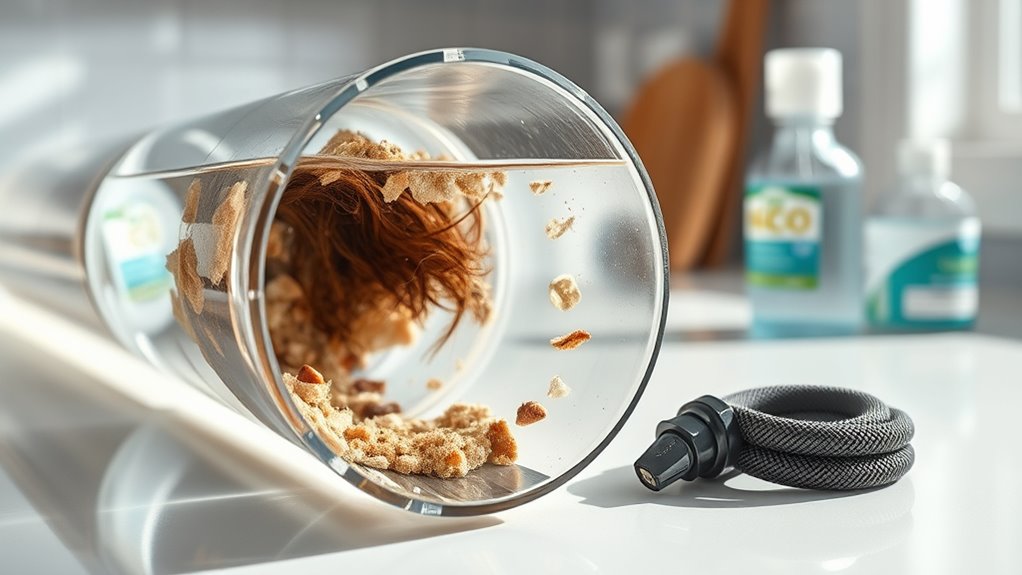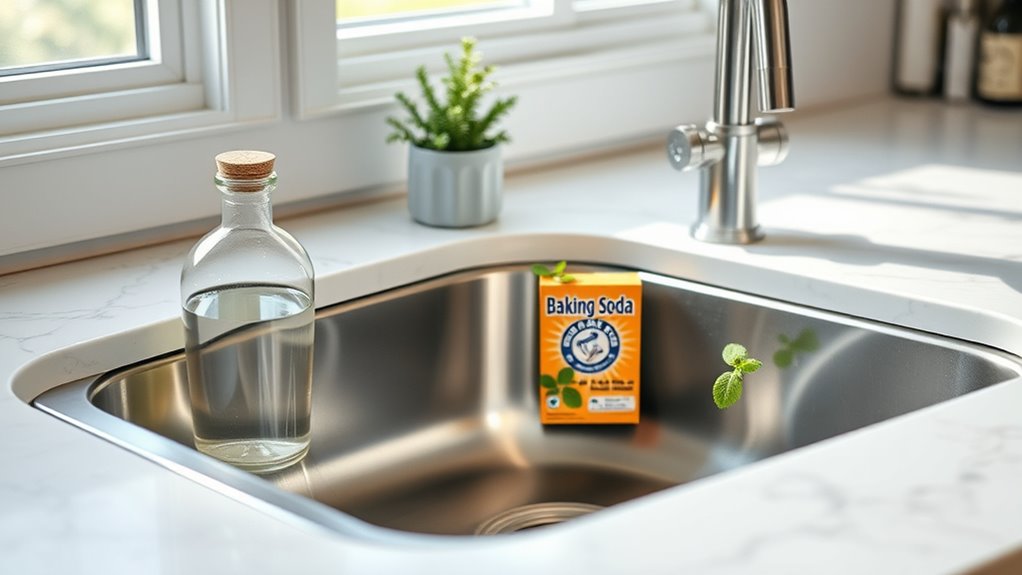Best Methods to Clean Pipes Safely and Effectively at Home
To clean pipes safely and effectively at home, individuals can use various methods. Boiling water dissolves grease, while a baking soda and vinegar mixture reacts to dislodge debris. A plumber’s snake can reach clogs deep in pipes, while natural cleaners like salt and baking soda are safer alternatives. Regular maintenance, including hot water flushes and mindful disposal practices, can prevent future issues. For deeper problems, expert advice may be necessary. More insights on this topic await exploration.
Understanding Pipe Clogs and Their Causes

While many homeowners may overlook the importance of maintaining their plumbing systems, understanding pipe clogs and their causes is essential for preventing costly repairs.
Clogs can occur due to a variety of factors, including the accumulation of hair, soap scum, grease, and food particles in kitchen and bathroom drains. Over time, these materials build up, restricting water flow and leading to blockages.
Additionally, tree roots can infiltrate underground pipes, causing significant obstructions. Poor pipe installation or aging infrastructure may also contribute to frequent clogs.
Homeowners should be aware of warning signs, such as slow drainage or unusual noises, to address potential issues early. By identifying the causes of clogs, they can take proactive measures to protect their plumbing systems.
Importance of Regular Pipe Maintenance
Regular pipe maintenance is essential for ensuring a plumbing system operates efficiently and remains free from costly clogs. Neglecting this critical aspect can lead to severe issues, including leaks, burst pipes, and water damage.
Routine inspections can help identify early signs of wear and tear, allowing homeowners to address potential problems before they escalate. Additionally, regular cleaning can prevent the buildup of debris, grease, and mineral deposits that can impede water flow.
Tools You Need for Effective Pipe Cleaning
Effective pipe cleaning requires the right tools to maintain ideal plumbing performance and prevent future issues.
Essential tools include a plumber’s snake, which effectively removes clogs and debris from pipes. A high-quality plunger is also essential for dislodging blockages in sinks and toilets.
For routine maintenance, a pipe brush can help keep pipes clear of buildup, particularly in narrower plumbing systems.
Additionally, a wet/dry vacuum can assist in removing excess water and debris, providing a thorough clean.
Chemical drain cleaners may be useful but should be used sparingly and with caution.
Finally, safety gear such as gloves and goggles is critical to protect oneself during the cleaning process.
Having these tools on hand guarantees effective pipe maintenance and prevents plumbing issues.
Boiling Water Method
One straightforward yet powerful technique for clearing minor clogs is the boiling water method. This method involves bringing a pot of water to a rolling boil and then carefully pouring it down the affected drain.
The high temperature of the water helps dissolve grease, soap scum, and other debris that may be causing the blockage. For best results, it is advisable to repeat this process two to three times, allowing the hot water to work through the pipes thoroughly.
However, homeowners should exercise caution, particularly with plastic pipes, as extreme heat can cause damage. This method serves as an effective first step in addressing minor drainage issues before considering more intensive cleaning solutions.
Baking Soda and Vinegar Solution
The baking soda and vinegar solution is a popular method for cleaning pipes due to its chemical reaction that produces carbon dioxide.
This reaction helps to dislodge debris and build-up within the pipes. However, understanding the application process and the effectiveness and limitations of this method is essential for achieving ideal results.
Chemical Reaction Explained
A common and popular method for cleaning pipes involves the chemical reaction between baking soda and vinegar. This reaction is characterized by the production of carbon dioxide gas when these two substances combine.
Baking soda, or sodium bicarbonate, is a weak base, while vinegar contains acetic acid. When mixed, they undergo an acid-base reaction, resulting in the formation of carbonic acid, which quickly decomposes into water and carbon dioxide.
The release of carbon dioxide creates bubbling and fizzing, which helps to dislodge debris and buildup within pipes. This natural reaction is not only effective but also safe, making it an environmentally friendly alternative to harsh chemical cleaners.
Understanding this chemical reaction can enhance the effectiveness of using baking soda and vinegar for pipe cleaning.
Application Process Steps
To effectively clean pipes using a baking soda and vinegar solution, the application process must be followed meticulously.
First, the area around the drain should be cleared to allow easy access.
Next, a half-cup of baking soda is poured directly into the drain. Following this, a half-cup of vinegar is added, which will create a fizzing reaction.
The drain should then be covered with a stopper or cloth to contain the reaction and enhance cleaning efficacy.
After allowing the mixture to sit undisturbed for 30 minutes, hot water should be poured down the drain to flush out any loosened debris.
Finally, a thorough inspection of the drain confirms that it is clear and functioning properly, completing the cleaning process.
Effectiveness and Limitations
While many homeowners turn to the baking soda and vinegar solution for pipe cleaning, its effectiveness can vary based on several factors.
This method is often praised for being eco-friendly and cost-effective, but it has limitations that users should consider.
- Type of Clog: The solution may be effective for minor clogs caused by grease or soap scum but struggles with more stubborn blockages.
- Pipe Material: Certain pipes may react negatively to the acidity of vinegar, potentially causing damage over time.
- Method of Use: Proper application is essential; insufficient amounts or incorrect timing can lead to subpar results.
Ultimately, while baking soda and vinegar can be a useful cleaning technique, its success is not guaranteed in every situation.
Salt and Baking Soda Mixture
The salt and baking soda mixture is a powerful and straightforward option for cleaning pipes.
This method combines readily available ingredients, creating an effective solution to tackle clogs and build-up.
Ingredients for Effective Mixture
Combining salt and baking soda creates a powerful mixture that effectively tackles stubborn clogs in pipes. This combination harnesses the abrasive properties of salt and the alkaline nature of baking soda, making it an ideal solution for cleaning.
Key ingredients for this effective mixture include:
- Table Salt: Acts as a gentle abrasive to help dislodge debris and buildup.
- Baking Soda: Provides a chemical reaction that helps break down grime and grease.
- Hot Water: Enhances the effectiveness of the mixture by dissolving the ingredients and aiding in the removal of clogs.
When used together, these ingredients create a dynamic cleaning solution, making them essential for any DIY plumbing maintenance routine.
This safe and effective method can help keep pipes clear and functioning efficiently.
Step-by-Step Cleaning Process
To effectively clean pipes using the salt and baking soda mixture, one must follow a straightforward step-by-step process.
First, gather a half cup of salt and a half cup of baking soda.
Next, pour the mixture directly into the pipe, ensuring it reaches the clogged areas.
After that, allow it to sit for approximately 15 minutes, giving the ingredients time to work on the buildup.
Following the waiting period, heat a pot of water to boiling and carefully pour it down the pipe. This step helps to flush out the mixture along with any loosened debris.
Finally, run cold water for a few minutes to clear any remaining residue, ensuring the pipes are clean and functioning properly.
Benefits of Using Mixture
Utilizing a salt and baking soda mixture for cleaning pipes offers several advantages that enhance both efficiency and effectiveness.
This combination creates a powerful cleaning reaction, making it a preferred choice for many homeowners.
- Natural Ingredients: Both salt and baking soda are non-toxic, ensuring a safe cleaning process without harmful chemicals.
- Cost-Effective: This mixture is affordable and readily available, providing an economical solution for pipe maintenance.
- Odor Neutralization: The mixture helps eliminate unpleasant odors, leaving pipes fresh and clean after use.
Dish Soap and Hot Water Technique
A simple yet effective method for cleaning pipes involves the use of dish soap and hot water. This technique is particularly useful for removing grease and grime build-up. The process is straightforward; one simply needs to mix a generous amount of dish soap with boiling water and pour it down the affected pipes.
| Step | Action |
|---|---|
| 1 | Boil water in a kettle. |
| 2 | Add dish soap to the water. |
| 3 | Stir until mixed well. |
| 4 | Pour the mixture down pipes. |
| 5 | Flush with cold water. |
This method not only cleans but also helps maintain the plumbing system, promoting better water flow and preventing clogs over time.
Using a Plumber’s Snake
When considering the use of a plumber’s snake, selecting the appropriate size is vital for effective cleaning.
Proper technique is also essential to navigate the bends and clogs within the pipes.
Understanding these factors can greatly enhance the overall efficiency of the pipe-cleaning process.
Choosing the Right Size
Selecting the appropriate size of a plumber’s snake is essential for effective pipe cleaning. The size of the snake must match the diameter and type of the pipes being serviced to guarantee peak performance.
Using a snake that is too small may fail to clear clogs, while one that is too large can damage pipes.
Consider the following factors when choosing the right size:
- Pipe Diameter: Select a snake that fits comfortably within the pipe’s diameter for efficient cleaning.
- Type of Clog: A larger snake may be necessary for stubborn blockages, while smaller ones work for minor clogs.
- Pipe Material: Different materials may require different sizes or types of snakes to avoid damage.
Choosing wisely can greatly enhance cleaning effectiveness.
Proper Technique Usage
Using a plumber’s snake requires a clear understanding of the proper techniques to guarantee effective cleaning without damaging the pipes.
First, the individual should verify the snake is fully inserted into the drain until resistance is felt, indicating a clog. It is essential to rotate the handle clockwise while gently pushing forward to allow the snake to navigate through bends.
If the clog isn’t resolved, the user should retract the snake carefully, removing any debris attached. Repeating this process may be necessary for stubborn clogs.
Additionally, it is vital to maintain a steady hand and avoid excessive force, as this can lead to pipe damage. Proper technique guarantees efficient cleaning while preserving the integrity of the plumbing system.
Hydro Jetting for Stubborn Clogs
Although traditional methods like snaking can effectively clear minor blockages, hydro jetting stands out as a powerful solution for stubborn clogs. This technique utilizes high-pressure water jets to dislodge and eliminate deep-rooted debris.
Hydro jetting is particularly beneficial in the following ways:
- Thorough Cleaning: It removes not just clogs but also grease, scale, and mineral buildup from pipe walls.
- Environmentally Friendly: This method uses only water, avoiding the harsh chemicals associated with other cleaning methods.
- Long-Lasting Results: Regular hydro jetting can prevent future blockages, reducing the need for frequent interventions.
Chemical Drain Cleaners: Pros and Cons
Chemical drain cleaners offer a quick solution for clearing clogged pipes, but their effectiveness can vary.
While they may provide immediate relief, they also pose health and safety risks due to their corrosive nature and harmful fumes.
Understanding both the benefits and drawbacks is essential for making an informed choice.
Effectiveness of Chemical Cleaners
Many homeowners turn to chemical drain cleaners as a quick solution for clogged pipes, drawn by their convenience and immediate results.
These products are designed to dissolve blockages and restore proper flow. However, their effectiveness can vary greatly based on the type of clog and the cleaner used.
Key points about the effectiveness of chemical cleaners include:
- Speed: Many chemical cleaners work within minutes, providing rapid results for minor clogs.
- Types of Clogs: They are particularly effective against organic material like hair and grease but may struggle with solid obstructions.
- Limitations: Repeated use can lead to pipe damage, especially in older plumbing systems, making it important to use them judiciously.
Homeowners should consider these factors before relying solely on chemical solutions.
Health and Safety Risks
Using chemical drain cleaners can present significant health and safety risks that homeowners should be aware of.
These products often contain caustic substances that can cause chemical burns, respiratory issues, and eye damage upon contact or inhalation. Improper use may also lead to dangerous reactions, especially when mixed with other household chemicals.
Additionally, the potent ingredients can pose environmental hazards if they enter water systems, affecting aquatic life. While chemical drain cleaners are effective for clearing clogs, their risks necessitate careful handling, including wearing protective gear and ensuring proper ventilation.
Homeowners should weigh these dangers against potential benefits, considering safer alternatives for routine maintenance and emergency situations. Ultimately, informed choices will enhance safety and reduce health risks.
Eco-Friendly Cleaning Alternatives

How can homeowners maintain clean pipes without resorting to harsh chemicals? Eco-friendly cleaning alternatives offer effective solutions that minimize environmental impact.
These natural methods can be both safe and efficient for pipe maintenance.
- Baking Soda and Vinegar: This classic combination can dissolve buildup and odors when poured down the drain, creating a fizzy reaction that helps clear clogs.
- Salt and Hot Water: Pouring a mixture of salt and boiling water down the pipes can help break down grease and debris, promoting cleaner plumbing.
- Lemon Juice: The acidity of lemon juice can aid in breaking down mineral deposits and providing a fresh scent to pipes.
Preventive Measures to Avoid Future Clogs
Maintaining clean pipes goes hand in hand with implementing preventive measures to reduce the risk of future clogs. One effective strategy involves regularly inspecting and cleaning drain screens or stoppers, which can trap debris before it enters the plumbing system.
Additionally, homeowners should avoid disposing of grease, coffee grounds, and fibrous materials down the sink, as these substances can accumulate and cause blockages. Flushing the pipes with hot water periodically can help dissolve potential build-up.
Moreover, using a drain cleaner made from natural ingredients can aid in maintaining clear pipes without harsh chemicals.
Finally, ensuring that trees and shrubs are planted at a safe distance from sewer lines can prevent root intrusion, which is a common cause of severe clogs.
When to Call a Professional Plumber
While some plumbing issues can be resolved with DIY methods, certain situations warrant the expertise of a professional plumber.
Recognizing these scenarios can save homeowners from further complications and damage. A professional should be called in the following instances:
- Persistent Clogs: If clogs remain after multiple attempts to clear them, a deeper issue may be present.
- Leaking Pipes: Continuous leaks can lead to water damage and mold growth, necessitating immediate attention.
- Sewage Backup: This is a serious health hazard and requires the expertise of a professional to manage safely and effectively.
In these circumstances, engaging a skilled plumber guarantees that the problem is resolved efficiently, safeguarding the home and its plumbing system.
Safety Precautions While Cleaning Pipes
Safety is paramount when cleaning pipes, as improper handling can lead to accidents or injuries. Individuals should always wear protective gear, such as gloves and goggles, to shield against chemicals and debris. Proper ventilation is crucial, especially when using harsh cleaning agents. Additionally, it’s wise to have a first-aid kit on hand in case of minor injuries.
| Safety Measure | Description |
|---|---|
| Wear Protective Gear | Gloves and goggles to prevent injury |
| Guarantee Ventilation | Open windows or use fans |
| Read Instructions | Follow product guidelines carefully |
| Keep First-Aid Kit | Be prepared for minor injuries |
| Avoid Mixing Chemicals | Can lead to dangerous reactions |
Maintaining Clean Pipes Year-Round
Clean pipes require consistent attention throughout the year to prevent buildup and clogs. Regular maintenance not only guarantees functionality but also prolongs the lifespan of plumbing systems. Homeowners can adopt several effective strategies to maintain clean pipes.
- Routine Flushing: Periodically flush pipes with hot water to dissolve grease and debris.
- Natural Cleaners: Use vinegar and baking soda monthly to break down minor clogs and neutralize odors.
- Mindful Disposal: Avoid putting grease, fibrous foods, and non-biodegradable items down the drain to minimize residue.
Conclusion
In summary, maintaining clean pipes is akin to nurturing a garden; regular care prevents weeds from taking root. By employing methods such as boiling water and the baking soda-vinegar solution, homeowners can effectively tackle clogs while promoting longevity in their plumbing systems. Emphasizing preventive measures and safety precautions guarantees a smooth flow year-round. However, when faced with stubborn blockages, enlisting the help of a professional plumber may be the wisest choice, safeguarding both time and peace of mind.




